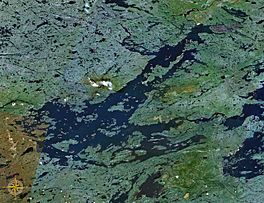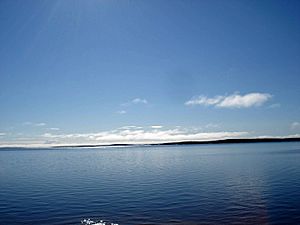Robert-Bourassa Reservoir facts for kids
Quick facts for kids Robert-Bourassa Reservoir |
|
|---|---|
 |
|
| Location | Baie-James, Jamésie Territory, Quebec |
| Coordinates | 53°45′N 77°00′W / 53.750°N 77.000°W |
| Lake type | Artificial |
| Primary inflows | La Grande River |
| Primary outflows | La Grande River |
| Catchment area | 97,643 km2 (37,700 sq mi) |
| Basin countries | Canada |
| Surface area | 2,835 km2 (1,095 sq mi) |
| Average depth | 21.8 m (72 ft) |
| Max. depth | 137 m (449 ft) |
| Water volume | 61.7 km3 (14.8 cu mi) |
| Residence time | 0.5 years |
| Shore length1 | 4,550 km (2,830 mi) |
| Surface elevation | 175 m (574 ft) |
| 1 Shore length is not a well-defined measure. | |
The Robert-Bourassa Reservoir (in French: Réservoir Robert-Bourassa) is a huge man-made lake in northern Quebec, Canada. It was built in the mid-1970s as part of the James Bay Project. This big project helped create electricity using the power of water.
The reservoir provides the water needed for two important power stations: the Robert-Bourassa and La Grande-2-A generating stations. These stations turn the force of water into electricity for homes and businesses.
About the Reservoir
The Robert-Bourassa Reservoir is very large. Its surface area can reach up to 2,835 square kilometers (1,095 square miles). The water level changes, but it is usually between 168 meters (551 feet) and 175 meters (574 feet) high.
The reservoir holds a lot of water, about 61.7 cubic kilometers (14.8 cubic miles). A big part of this water, about 19.4 cubic kilometers (4.6 cubic miles), can be used to make hydro-electric power.
How the Reservoir Was Made
The reservoir was created by building the Robert-Bourassa Dam across a valley of the La Grande River. This dam is a very impressive structure.
Workers built the main dam between 1974 and 1978. It is 550 meters (1,800 feet) wide at its bottom. To build it, they used 23 million cubic meters (30 million cubic yards) of earth and rock.
Besides the main dam, there are 31 smaller dikes around the reservoir. These dikes are like walls that help keep all the water safely inside the reservoir.
See also
 In Spanish: Embalse Robert-Bourassa para niños
In Spanish: Embalse Robert-Bourassa para niños



